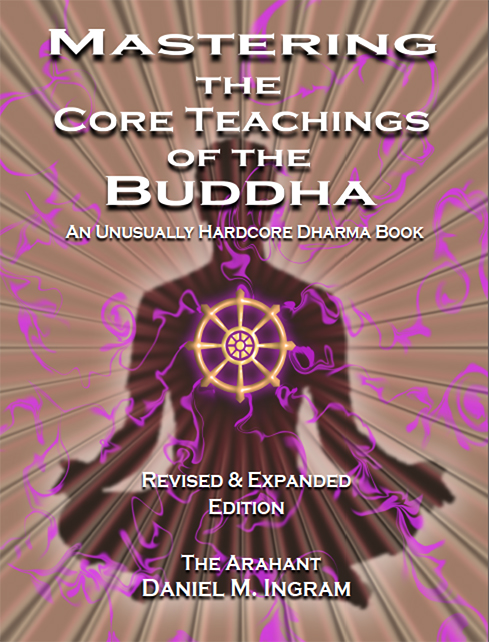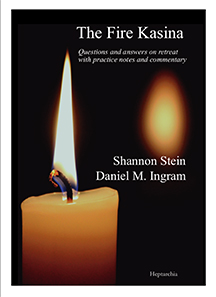56. Wandering
← 55. Map Failure | 57. Kasinas, Powers, and Retreats →
It was during this time, specifically 1998 or so—when the dark side of misapplied dharma practice was interfering with my initial dharma friendships—that I met Robert Burns. He is now the ex-husband of my sister’s husband’s sister, aka my ex-brother-in-law-in-law. He was into Ceremonial Magick and was a very heavy Thelemic practitioner. With him being my one close meditation friend at that time, I spent a whole lot of time reading various books about magick, experimenting with various magickal techniques, and doing a lot of concentration practices involving kasinas, trying to draw lines in the air, and visualizing various archetypical images and geometric designs, etc. Robert and I spent long hours over many months trying to correlate the stages in the maps of our various traditions, and the correlations with the stages of insight and the sephirot came from those conversations. He and his ex-wife, my sister’s husband’s sister, also gave me my first website and named it www.interactivebuddha.com, and he hosted it on his server for the first ten years of its existence, for which I am very grateful.
Magickal work helped fill in the far other end of the developmental spectrum for me, being about meaning, symbols, and content. It was about feelings, desires, fears, empowerment, intuition, creativity, and the specifics of life. One of the shadow sides of relentless focus on vipassana, impermanence, suffering, and the like is that we can become so down on the life-giving side of the spiritual equation, and neglect meaning and content. So magick helped me begin to correct some of that imbalance. In magick, colors mattered. Words mattered. Archetypes mattered. Dreams mattered. Relationships mattered. Feelings mattered. It is not that the practices I had been doing or the tradition in which I had been practicing in necessarily devalued those aspects of life, but my interpretation of those traditions and practices did.
While all those aspects of life were clearly very relevant in a Buddhist context in which morality has been adequately understood and sufficiently cultivated prior to meditation, magick had this deep cultural resonance for me—the heroes of my youth were not Padmasambhava or Asian mythical creatures such as garudas and nagas, but Gandalf, elves, fairies, and dragons. Wands mean more to me than dorjes at some deep level, not that I don’t like a good dorje now and then. The Western magickal tradition could unlock forgotten places and play to deep heart-related areas that Buddhist symbolism just couldn’t do for me. I get goose bumps when I read Harry Potter. It is just the culture I grew up in. Someone growing up in a different culture would likely have different triggers for similar reactions. One day I think there will be a translation of tantra into Western iconography but, until then, I draw on the iconography and myths of both Eastern and Western traditions to meet my needs. For me, magick was like the deep end of psychotherapy for meditators plus a whole lot more. I got a lot out of it then and still do.
From about 1998 to late 1999, Robert was basically the only friend with whom I consistently conversed about meditation. I had a brief period in late 1996 through 1998 where I tried to be involved in various local meditation groups in North Carolina, but I found them all very frustrating and felt like I was into something very different from what the rest of the participants were interested in, so the fit was extremely awkward. I did meet some very nice, good people in those groups, but I finally gave up on being part of a local group. As confirmed by many similarly solid practitioners with whom I have communicated since then (mostly as a result of the internet, and therefore about a decade later), when you have such a radically different set of abilities and have undergone such complex paradigmatic and perceptual transformations, it is very hard to be around those who see the dharma more as a club, social scene, church, hobby, recreational activity, fancy feather in their cap, set of fascinating beliefs, exotic self-identification, job, or something beyond questioning. I found that while people liked to imagine that they were self-identified as Buddhists and purportedly into Buddhism, when I talked about the fascinating results that actual Buddhist practice can produce, all hell would break loose. That said, part of the problem was no doubt me and my presentation style, and I try to own that in relative terms as best I can.
My own real arrogance about my practice, coupled with my honestly hyper-enthusiastic, heartfelt desire to help spread knowledge of these outrageously incredible methods, collided with the other practitioners’ deep-seated beliefs or existential insecurities that there was no possible way someone like me or perhaps anyone alive today could possibly have done what I did, experience what I was experiencing, or know what I knew. Any possibility of that experience being the case was so threatening to their view of how the world worked that the results ranged from very polite disdain followed by their avoiding or shunning me, to actual snarls and people verbally assaulting me. Then I would go home and sit down and experience all the things they insisted were impossible.
I was alone and struggling to find companions on this strange path, particularly anyone who knew more than I did, to help me finish what I wished to finish. Those in most local groups were largely united in their view that I shouldn’t exist, was seriously delusional, and should at least shut up if not immediately vanish. Now, let me add that there were a few people who would warily listen and perhaps process something of what I had to offer, but that was so rare as to leave me feeling worse about the possibility of finding any real community than when the conversation started. Luckily, years later the internet has allowed these few people who really like to explore the deep end of meditation and talk about it to come together virtually on forums, Skype, Google Chat, etc., as well as occasionally to gather in meatspace to talk and share, and I am extremely grateful to be able finally to participate in such a community.
Back to the more linear narrative: other things that fascinated me during the time from around 1997 to 2002 were Vajrayana, Dzogchen, the writings of Chögyam Trungpa Rinpoche, particularly the ninth chapter of his book Journey without Goal about the five Buddha families, which describes various archetypical energies and qualities of being, and how these relate to skillful and unskillful ways of being in the world. It seemed to fill in human dimensions of theory that I had been lacking, and so that period involved a lot of time spent relating to such energies, to the transformation of the various defilements into their awakened counterparts, a view that saw them all as energetic, colorful qualities moving in the world that could either be experienced in the light of duality or in the light of their essential nature.
This point of view now made vastly more experiential sense to me than the traditional ten fetter model (as it is usually explained). I also really liked Trungpa Rinpoche’s book Training the Mind and Cultivating Loving-Kindness and the tonglen practice he describes there. I spent a reasonable amount of my formal practice doing that and the brahma viharas along with my other strange magickal and more exploratory vipassana work, as the cycles were the cycles, and those practices more than anything seemed to move those cycles along quickly, which seemed like a good idea and probably was.
The Vajrayana teachings, even in the very limited, distorted, translated, indirect way they came to me, had the profound effect of largely liberating me from the ideals related to eliminating the negative emotions by way of suppression or repression. This had the good effect on my insight practice of really allowing me to embrace whatever came up however it was. My ideals based on the Theravada had been largely shattered by that point, as their traditional models simply didn’t line up well enough with my experience anymore to make any sense to me.
The Vajrayana concept of embracing all energetic emotional qualities to bring the light of wisdom to them made vastly more sense and allowed me to open to depths of my emotional life that I suspect would have been much harder had I been laboring under the Theravada models. Simultaneously, this also lowered my standards for my emotional life in relative terms, which probably wasn’t helpful or necessary. It is hard to spend hours on the cushion totally embracing our emotions however they are and not have that cause some shadow side of too much unrestrained behavior when off the cushion. The Vajrayana kids know this all too well, hence the emphasis on establishing a firm foundation in morality, the preliminaries, warnings, bodhisattva vows, and safeguards that always traditionally accompany these teachings.
Also helpful in that period was Padmasambhava’s The Light of Wisdom, with commentary by Jamgon Kongtrul Rinpoche the Great, as well as Tracing Back the Radiance from the teachings of Chinul, a Korean Chan monk, which Joseph Goldstein had recommended to me for the general territory he felt I was in. I was also influenced by Introduction to Tantra, by Lama Yeshe, and later by Secret of the Vajra World, by Reginald Ray, as well as texts such as Liberation in the Palm of Your Hand, by Pabongka Rinpoche. I read a lot of Taoist material in odd sources like the beautiful cartoon books of Tsai Chih Chung, such as The Roots of Wisdom (which is not strictly Taoist, but is in the ballpark). I read Moon in a Dewdrop about the teachings of Doˉ gen many times. This is a very incomplete list, but it gives you a sense of my interests and what I resonated with at the time.
Despite reading lots of books I still found nothing that really mapped out what I was going through or that clearly explained how to dissolve the last little annoying remnants of dualistic illusion in a way that I could understand at the time. Descriptions of the high end of the middle paths are very hard to come by, and good advice even harder. So, I wandered a bit, explored, and pursued all sorts of strange paths that might be considered either distractions from a purist’s point of view, or a well-rounded education in developing more broadly.

